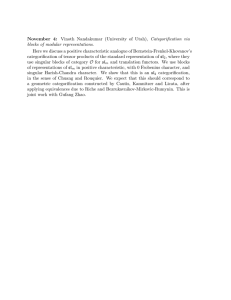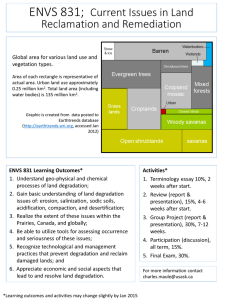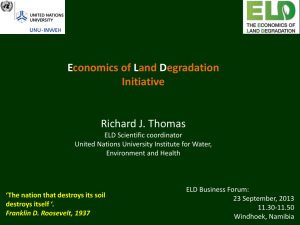Adapting to Climate Change and Addressing Land Degradation through Sustainable Land
advertisement
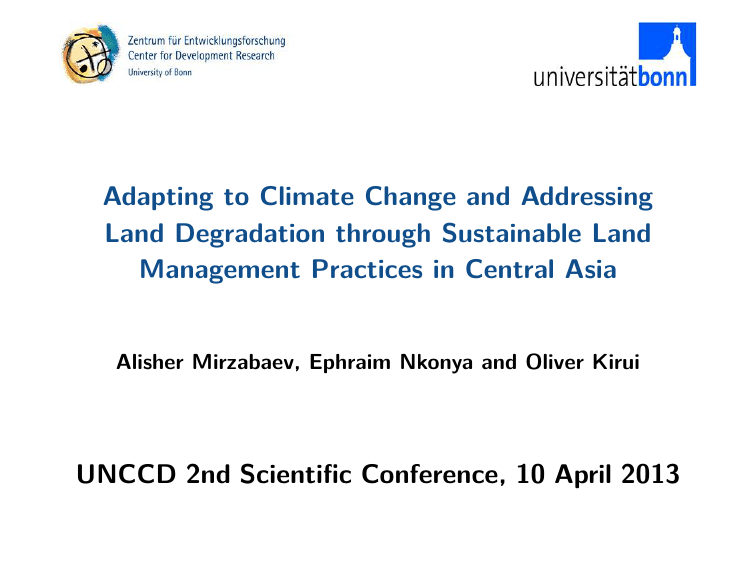
Adapting to Climate Change and Addressing Land Degradation through Sustainable Land Management Practices in Central Asia Alisher Mirzabaev, Ephraim Nkonya and Oliver Kirui UNCCD 2nd Scientific Conference, 10 April 2013 Problem Definition Empirical steps and Data Results Conclusions Central Asia: a Brief Background I Intrinsic climate variability I Considerable and growing problems of land degradation I Importance of agriculture for rural incomes Source for the map: Philippe Rekacewicz, UNEP/GRID-Arendal 2 Problem Definition Empirical steps and Data Results Conclusions Climate Change in Central Asia Climate variables Past Trends Future Forecasts Temperatures increase increase Precipitation increase no consensus Irrigation water no trend no consensus high higher Weather variability I Agricultural producers in Central Asia operate in intrinsically stressed environments, which may provide them with experiences to dynamically adapt to the ongoing changes. Adaptation is likely to minimize the negative impacts of climate change on agricultural production in the region (Mirzabaev 2013) 3 Problem Definition Empirical steps and Data Results Conclusions Land Degradation in Central Asia I Land degradation is estimated to cause losses reaching up to 2 bln USD annually in Central Asia (World Bank 1998, CACILM 2006) I Land degradation was found to reduce agricultural household incomes in the region (Aw-Hassan and Mirzabaev 2007) I Continued land degradation in Central Asia could lead to significant releases of CO2 to the atmosphere, contributing to climate change (Johnson et al. 1999) I On the other hand, climate change could exacerbate land degradation challenges in the region (Gupta et al. 2009) 4 Problem Definition Empirical steps and Data Results Conclusions Problem Statement I Land degradation is a major contemporary environmental problem negatively affecting agricultural production and rural livelihoods in Central Asia. I Climate change may exacerbate land degradation, in addition to its other potentially negative impacts in the region. I Therefore, there is a need for adaptation actions, including SLM technologies, policies and institutions, which will enable to both address land degradation and adapt to climate change simultaneously. 5 Problem Definition Empirical steps and Data Results Conclusions Research Question and Objectives I I I How climate change and land degradation may interact in Central Asia? Is adoption of SLM technologies susceptible to increase rural incomes? What are the key drivers for climate change adaptation through adoption of SLM technologies? 6 Problem Definition Empirical steps and Data Results Conclusions Secondary Data I I I I I I Provincial scale (cross-sections = 38, time period = 1990-2010) Agricultural production (crop yields and areas, input use) Institutional variables: market access, NASA night-time lighting intensity series Climate variables: temperature and precipitation. Climate variables from individual stations spatially interpolated using inverse distance weighting for extracting household specific variables or province averages. Other agro-ecological variables (soils, length of growing period, land degradation, AEZ, farming systems, etc) Climate change forecasts (IPCC, ICARDA) 7 Problem Definition Empirical steps and Data Results Conclusions Primary Data I I I I Nationally representative agricultural household surveys (4 countries, N = 1600) Sampling strategy: 1) random selection of provinces within agro-ecologies, 2) random selection of villages in each province, 3) random selection of respondents in each village. Sample size per country 400 respondents. Respondents allocated per selected province based on the share of the province in the national agricultural GDP and total number of agricultural producers. Surveys conducted in 3-4 stages during the 2009-2010 cropping season to facilitate recollection. 8 Problem Definition Empirical steps and Data Results Conclusions Joint Impacts of Climate Change and Land Degradation on Net Agricultural Revenues I Higher weather variability in temperature and precipitation, as well as higher plot level soil erosion reduce net agricultural profits. I Their interaction could increase the negative impacts, i.e. farmers operating in degraded soils could by hit more strongly by weather variability under climate change. 9 Problem Definition Empirical steps and Data Results Conclusions Impact of SLM adoption on Household Incomes I SLM adoption seems to lead to higher household food consumption, especially for the poorest agricultural producers. 10 Problem Definition Empirical steps and Data Results Conclusions Drivers of SLM Adoption I Econometric analysis of household data indicated that: I SLM technologies are also serving as coping practices against weather shocks. However, their adoption in such cases is often in response to weather shocks rather than pro-active and planned. I SLM adoption rates are lower among poorer households – who are in fact more affected by land degradation and have lower climate change adaptive capacities – which may require supportive actions targeting SLM adoption by the poor (but also development of poor–friendly low cost SLM technologies) I Higher market access, diversified crop portfolio, secure land tenure were found to lead to higher SLM adoption rates. 11 Problem Definition Empirical steps and Data Results Conclusions Next steps I These results are obtained using farmers’ perception about soil erosion in their field (there may be complex behavioural endogeneity issues), so need to cross-check using externally observed and objectively measured land degradation indicators. I Use not only farmers perceptions, but also actually measured indicators of land degradation (high resolution NDVI values, ...) for assessing joint impacts of climate change and land degradation at household level. I Account for possible endogeneity between farmers’ food consumption expenses and adoption of SLM practices. 12 Problem Definition Empirical steps and Data Results Conclusions Key Conclusions and Policy Implications I Climate change may further exacerbate existing land degradation challenges in Central Asia. I Most SLM practices recommended in Central Asia can also serve as no–regret adaptation options under climate change. I Wider applications of SLM practices is susceptible to yield multiple benefits in terms of addressing land degradation, adapting to climate change, improving crop yields and raising agricultural incomes. I The Governments in the region are undertaking considerable efforts in improving the resource use efficiency of agriculture. These efforts should be continued to strengthen the enabling framework for adoption of SLM technologies through information dissemination and farmer trainings, improved access to markets and credit, more secure land tenure and increased opportunities for crop diversification. 13 Problem Definition Empirical steps and Data Results Conclusions Aknowledgements 14

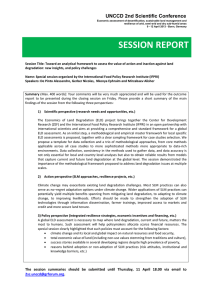
![Pre-workshop questionnaire for CEDRA Workshop [ ], [ ]](http://s2.studylib.net/store/data/010861335_1-6acdefcd9c672b666e2e207b48b7be0a-300x300.png)

